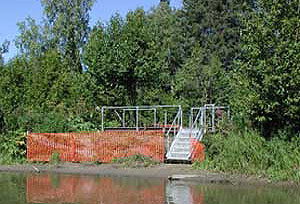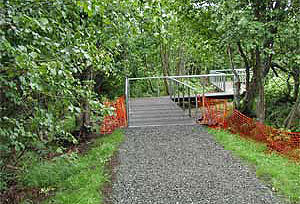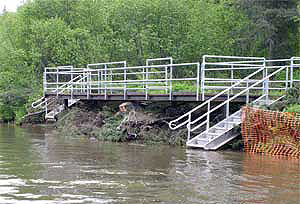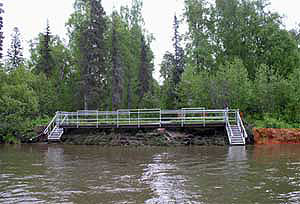Recreational Angler Access Projects
Southcentral
Little Susitna River
Description
Construction of the Little Susitna Public Use Facility (LSPUF) was completed in 1990, using Federal Aid in Sport Fish Restoration funds under project F-13-D-6. Originally constructed for boating access, this facility also offered about 600 feet of gravel trail access to the Little Susitna River bank fishery downstream of the boat launch. Substantial foot-accessed sport angling occurs along the riverbanks within ½ river mile from the LSPUF boat launch parking lot, primarily downstream of the launch area. Anglers accessing prime fishing waters beyond the terminus of the developed trail had, through continued use, worn a system of braided pathways along the shoreline and throughout the wetland and upland areas. These paths were narrow, brushy, and slick with mud. User created access points extending from the upland pathway to the river had destroyed riparian vegetation and exacerbated riverbank erosion. Improving the existing trail access and developing key river-access points to areas downstream of the LSPUF was needed in order to provide better, user-friendly access and to help protect shoreline habitat from further damage.


Location
View Larger Map
The appearance of a Google Maps link is not an Alaska Department of Fish and Game recommendation for or implied endorsement of Google Maps. Please also be aware that the provided latitude and longitude coordinates are approximations and are not intended for navigational purposes.
Purpose
The objective of this project was to improve foot access to the Little Susitna River for bank anglers fishing downstream of the LSPUF boat launch. The project was originally designed to provide a total of 2,000 feet of barrier free trail to access eight bank angling locations, an additional entry point from the boat launch parking lot, and an ADA fishing deck located at a prime bank angling site at the trail's terminus. Permitting agencies required the use of light penetrating steel grate walkway, steel grate access platforms and stairways, and some stream bank restoration work to repair user created habitat damage. Though the first half of the trail system was designed with a mixture of hardened gravel and walkway, the remainder of the trail extended through a wetland area and was designed entirely of light penetrating walkway as mandated by the permitting agencies. Funding for the project was not adequate to complete the entire project and only the first 850 feet of trail was completed. The completed portion of trail includes hardened gravel and light penetrating steel grated walkways and four steel grate platforms and aluminum stairways to provide designated fishing access to the river.


Outcome
The project was completed in August 2000. The barrier free developed trail system and river access platforms and stairways provide easier and greater accessibility for all sport anglers. The access platforms and habitat restoration and bank revetments at various disturbed shoreline areas has repaired user-created riparian damage. Providing stairs and containing access has minimized further bank erosion, allowed natural vegetation to return and provided users with a more aesthetically pleasing trail system. In addition to grant funding, volunteer labor was used to complete this project. The Youth Restoration Corps (YRC), a non-profit organization, provided most of the habitat restoration work and materials. Other volunteers from local schools and governmental agencies also assisted.
